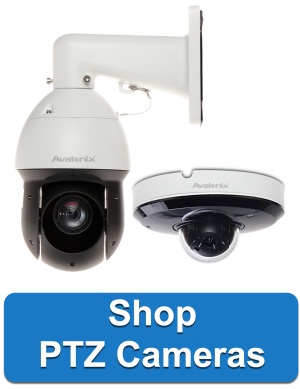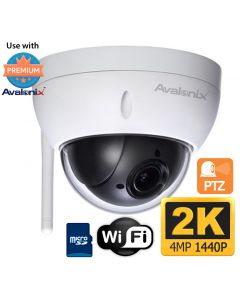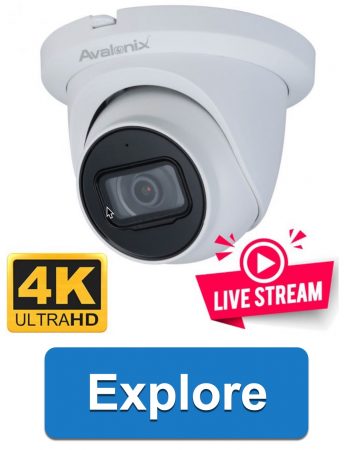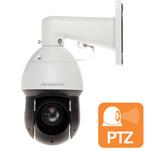
The word PTZ is short for "Pan Tilt Zoom." PTZ cameras are an ideal choice for both security and multimedia applications. They are adaptable enough to be utilized anywhere for any project because they can move around freely and have optical zoom, which comes in handy for long distance observation and surveillance. There are several types of PTZ cameras; they all contain a video camera module linked to servo and motor systems that allow the camera module to move. With so much technical jargon, so many features to pick from, and such a broad price range, it might be difficult to find the perfect Pan Tilt Zoom camera for your needs. We're happy to share our expertise and knowledge with you so that you can make a smart decision about which camera to buy.
What are PTZ cameras commonly used for?
A PTZ Camera is primarily used for security and designed with active surveillance in mind. Active surveillance is when someone, such as a security officer, watches the video feed and controls the camera to monitor an area of interest. Active surveillance is usually used to keep an eye on a person or thing of interest in busy places where loss or harm could happen, like a department store, airport, or train station.
Since 2010, IP camera technology has greatly improved and enabled lots of new features to be added. PTZ cams are now more robust than ever to take on both surveillance and non-security related applications such as live streaming over the Internet. They are no longer just surveillance cameras that require operator control for threat monitoring.
Security
Since the 1980s, PTZ cameras have been just general-purpose security cameras, such as Box CCTV cameras, attached to a motorized mount that provided pan and tilt capability. It was a primitive setup that required complicated wiring and expensive joystick controllers. These older camera setups typically required a person to actively control the camera.
Modern PTZ cameras move with their own motors and can take commands over the video cable, so they don't need complicated cable setups. For security, PTZs have improved a lot thanks to new features like presets that can be programmed, tours, scanning, and auto tracking.
Parking lots, driveways, and large properties are all popular locations for Pan Tilt Zoom security cameras. Since 2014, with simple commands such as presets, tours, and scans, users can use a single camera to keep an eye on more than one part of their property or business.
- A Preset is a saved position for panning, tilting, and zooming that the user has set.
- A Tour is a series of presets that can be called to set up an endless loop to monitor different areas of the property.
- Using Scan mode, a PTZ will pan and tilt according to a routine that has already been set. This makes it possible to scan an area without having to make individual presets.
Auto-tracking PTZ Cameras have been around since 2014, but they were pretty unreliable at first. With the help of improvements in AI-based Smart Motion Detection, Auto Tracking has become a reliable way to monitor low-traffic areas to follow trespassers on foot or slow moving vehicles since around 2020.
Live Streaming and Multimedia
Live streaming is becoming more and more popular on YouTube, Twitch, Facebook Live, and other websites. By embedding the feeds on their personal or business websites, many of our customers choose to stream video from some of our cameras. IP PTZ cameras, which are network-based cameras, are great for live streaming because you can change where the camera is pointed as you stream. We have assisted customers with the deployment of PTZs for live streaming various types of events, to name a few:
- Church Services
- Sporting Events
- Concerts
- Constructions Sites
- Zoo Habitats
- Weather Cams
- Scenic areas of cities, countrysides, beaches or lighthouses
Check out a real-life demonstration of live streaming cameras that we offer, which can stream directly to YouTube without needing a PC to transcode video.
Webcam and Personal Use
It is not uncommon to use PTZ IP cameras for reasons other than security and live streaming online. Customers have used our cameras for astronomy, to gaze at the stars, and to keep an eye on wildlife on their land. This is because the cameras have a strong zoom lens and precise motor control. The potential uses for Pan Tilt Zoom cameras are endless. Our customers watch and control their cameras from anywhere in the world by using our free remote viewing apps or PC software.
It is easy to use our free smartphone apps to control Pan, Tilt, and Zoom cameras from anywhere using a smartphone. All you need is an internet connection to the camera and on your phone. The image below shows the pan, tilt, and zoom functions of our 2K mini PTZ.
What to Consider When Buying a PTZ Camera
With so many features and specs to pick from, it can be tough to narrow down the selection of PTZs for your project. When deciding whether to buy a PTZ camera or a fixed security camera, you should think about the following:
- Will you have someone controlling the camera or do you need auto tracking?
- Do you need a Wireless vs Wired PTZ?
- Do you need Live Streaming PTZ cameras?
- What kind of cabling is needed for PTZ network connectivity?
- How far do you need to see?
- Do you need to see in complete darkness at night?
- Do you need AI features such as Smart Detection?
- Are there any environmental hazards the camera will be exposed to?
- How many days of video retention do you need?
We're here to assist you in figuring out which features you need, what they do, and why they're useful. Feel free to give us a call at (716) 229-0080 if you want to speak to a professional technician about purchasing a PTZ for your project.
Will you have someone controlling the camera or do you need auto tracking?
When buying a PTZ, the first thing to consider is whether you need a camera with Auto Tracking (AT). AT allows the camera to follow an object of interest, such as a slow-moving vehicle or person in a low-traffic area. To have AT work, a Smart Detection rule such as a tripwire or intrusion box is needed to sense if an object has crossed an entry point in view of the camera. When the rule is triggered, the camera will automatically follow the object until it can no longer see the object.
We suggest putting auto-tracking PTZs in areas with low traffic or at controlled entry points where valuable goods or raw materials are kept. We suggest AT for residential customers if they own a large property or have a driveway that a conventional camera cannot reliably record. On the other hand, AI and Smart Detection features tend to make cameras more expensive because they require more computing power and parts.
Auto-tracking technology can be used for more than just security. It can also be used for multimedia and live broadcasting. For instance, imagine a church service or speech in which a charismatic preacher moves around the stage. The camera can easily follow the preacher without requiring operator control. Another good example is not needing a camera operator to record lessons and lectures in a classroom or lecture hall.
Wireless vs. Wired PTZ
Our professional opinion is that you should use Wireless security cameras only if it is absolutely necessary to do so, that is, if you cannot run a cable from the camera to the local network. Wireless doesn't mean wire-free; professional WiFi security cameras require electricity from a nearby electrical outlet.
We carry a small selection of wireless PTZ cameras that can be paired with a WiFi network to easily stream video without needing any wires. You simply need to plug-in the camera to power using a 12V DC 1amp power adaptor.
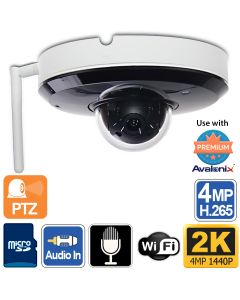 WiFi Mini PTZ with Night Vision, 2K, Built-in Microphone, 4X ZoomSpecial Price $309.99 Regular Price $399.99
WiFi Mini PTZ with Night Vision, 2K, Built-in Microphone, 4X ZoomSpecial Price $309.99 Regular Price $399.99
Just make sure that the WiFi signal is strong at the location where you intend to place the camera. Poor WiFi signals will cause issues by limiting the data throughput that is needed for a reliable stream and will cause latency in the video and lag in control of the camera.
By using a strong WiFi router or outdoor access point, it is possible to set up a professional wireless PTZ camera with reliable video streaming. We suggest using 2K resolution at maximum with WiFi cameras.
Wired cameras using PoE technology provide absolute stream stability and a worry-free experience. If you can run network cable, go with a wired PoE PTZ.
Live Streaming PTZ cameras
Most security cameras require a dedicated streaming program on a computer to transcode video into a compatible format for live streaming websites such as YouTube Live. We are proud to carry wired PoE IP PTZ cameras with built-in live streaming capabilities to meet the rising demand for internet streaming cameras.
Some of our PTZ models include built-in live streaming capability to send video and audio directly to websites such as YouTube Live, Twitch, and Facebook Live. Live streaming sites need both video and sound for a stream to work, and our cameras meet that requirement. Our cameras offer microphone or line-in inputs to accommodate security camera microphones for audio.
What kind of cabling is needed for PTZ network connectivity?
Almost all the PTZs we sell are PoE cameras, meaning they are able to receive power and send video over one network cable, making installation very simple. While PoE technology provides simplicity, there are some important considerations that need to be noted related to power and cable distance.
When choosing a PTZ, it is critical to consider the power and data transmission capabilities of PoE power and network cabling. Even when using solid copper CAT6 cable, cables for IP PoE PTZ cameras cannot be longer than 200 ft. For longer distances, you'll need a high-power PoE+ injector, but even with that, network cabling can only send data as far as 328 feet. For runs longer than 300 feet, specific PoE extenders are available but require careful consideration of the amperage required by the cameras.
How far do you need to see?
When choosing a PTZ, the video resolution and lens are the two most important features to think about for clear video at a distance. The DORI (Detect, Observe, Recognize, and Identify) distance ratings in the specifications of our cameras are a great way to narrow down your choices without knowing much about resolutions or lenses.
Video Resolution
PTZ cameras are available in a variety of video resolutions. The most popular resolutions are 2MP (1080P), 4MP (2K), and 8MP (4K). When you digitally zoom in on live or recorded video, the quality of the video depends a lot on the image resolution. You can expect more pixelation when using digital zoom with a 1080P camera when compared to a 4K camera. A 1080P camera, for example, may capture facial detail up to 20-30 ft away at its widest angle. A comparable 8MP camera can see facial features up to 50-70 feet away at its widest angle.
Lens Specification
While video resolution determines how much visual detail a camera can record, the lens it uses has a greater influence on the distance that it can view. A 1080P PTZ with a 25x zoom lens will be able to see farther than a 2K camera with a 12x zoom lens, but the recorded video at close range will offer less detail since digital zoom on recorded video is determined by resolution.
How zoom ratings are calculated
The zoom rating (x) of a lens is the ratio of the narrowest focal length to the widest. For example, if a 25x camera has a 120mm lens at its narrowest setting and a 4.8mm lens at its widest, 120 divided by 4.8 is 25.
There is, however, a tradeoff between having a higher optical zoom lens and lower resolution versus a lower optical zoom and high resolution. When the lens is zoomed in to see farther away, the field of vision changes a lot. As the camera zooms in, the angle of view narrows, and as it zooms out, the field of vision expands. When choosing a PTZ, the field of view should be taken into account based on how it will be used.
Do you need to see in complete darkness?
Some PTZs do not include IR night vision, so be sure to check the product description if you need a camera to see at night. Night vision capability is generally associated with the size of the optical zoom lens on the camera and the size of the camera itself.
The night vision range of the mini-PTZ cameras we sell is about 50 feet, which is enough to see basic details at night. The night vision range of larger PTZ cameras is usually between 300 and 500 feet, depending on the model and size of the camera.
Again, the simplest way to find out if a camera has IR night vision and its range is to look at its features list or specifications sheet.
AI Video Analytics such as Smart Detection
Smart Detection uses preset PTZ views to analyze the video feed and set off alarms, start recording, or automatically track with some models. These AI rules can also take a snapshot, send push notifications to smart phones, and send email alerts. All of our smart security cameras come with digital tripwire and intrusion detection as standard features. Some models also have advanced features like people counting, face recognition, and abandoned or missing object detection.
If you need a Pan Tilt Zoom Camera with video analytics for smart event detection, make sure the camera you choose has Smart Detection.
Are there any environmental hazards the camera will be exposed to?
It is very important to know the environment in which a PTZ will operate in order to protect your large investment from possible damage. The majority of outdoor security cameras we sell have an IP66 or higher weather rating, which means they will withstand rain or snow. But it's important to note that not all PTZs sold elsewhere offer the same level of protection for the environment.
The below image outlines what different IP ratings mean. Security cameras usually have a 6 as the first digit of the rating, which is dust protection for 2–8 hours. The second digit in the IP rating is pertinent to liquid protection. The higher the value of the second digit, the greater the protection against water. For example, all of our PTZs offer a minimum of IP66 protection, while consumer level or cheaper low-cost cameras are usually IP65.
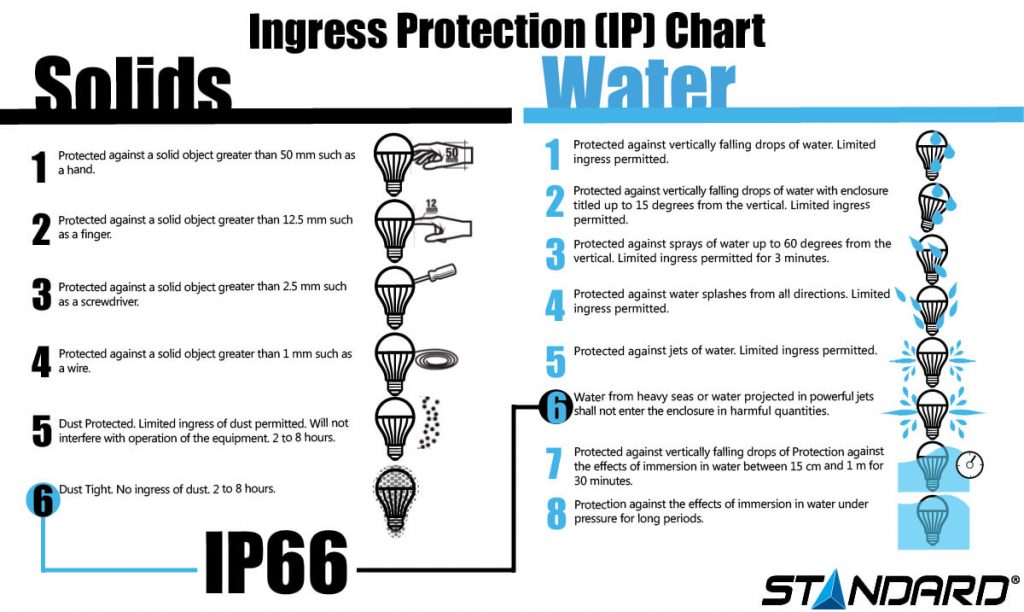
(source: stanpro.com)
Our cameras are professional products that are less affected by temperature because they can work in temperatures as low as -40F and as high as 140F. That is not to ignore that prolonged heat is tough on the electronics housed inside. Some large PTZs have cooling fans to combat heat-related wear and tear.
Lightning is a huge environmental concern. Many customers have made the mistake of installing their cameras on metal buildings or metal poles in the past. Attaching any camera to a metal structure is akin to making them lightning rods. Lighting will instantly destroy the camera's electronic internals by shocking them. The lightning strike doesn't have to be direct to the camera or the structure. As explained by EarthNetworks, indirect lightning strikes can travel through the ground until they reach another object. Metal buildings and metal poles are vulnerable and usually lead to damage to the camera, which can also travel back over the wire to other electronics.
How much video storage do you need?
All of our professional PTZ domes can be purchased with a microSD memory card that lets you record for 2-4 days, depending on the camera's resolution. You can use our security footage calculator to determine how much memory you'll need based on the resolution, frame rate, and number of days of recording desired.
If you're using a single camera as a standalone camera for your project, you might be interested in our security camera standalone guide, which shows what to expect when using one of our cameras as a standalone solution.
If you need video recording times longer than a few days, then we suggest purchasing an NVR recorder to make a proper PTZ camera system. Our NVRs range in capacity from 4 channel to 128 channel, and function as standalone units that can be used to make a closed CCTV system.

